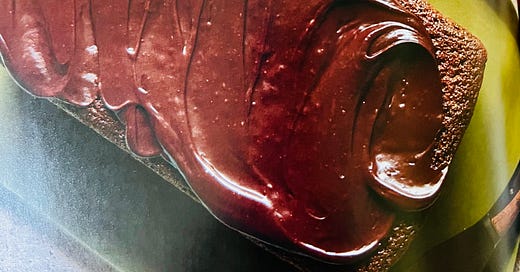Make Cake, Not War - No. 96
Visiting the past to make sense of the present & an eerily delicious chocolate cake served to the creators of the atom bomb
I’ve devoted my writing this month to topics related to the war in Ukraine, but no worries, in April I’ll be back to my usual content. I started writing on Substack nearly a year ago as a way to share my authentic self, what’s on my mind, what’s not in my cookbooks. This war is on my mind, and I welcome your feedback with open arms.
As the war in Ukraine wages, I stay fixated via TV while washing dishes in a warm house while a pot of soup simmers on my stove. Then comes the guilt. The war of good vs evil is a world away but that cannot erase the images I’ve seen—you’ve seen—of maternity hospitals blown up, lives destroyed, people willing to die to save their country, and of Europeans taking strangers into their homes to give them shelter.
And then the talk of nuclear arsenals, which brings to mind other wars, other times…
Edith Warner was a 30-year-old Philadelphia school teacher who moved to Los Alamos, New Mexico, in 1922, and fell in love with the natural beauty of the Southwest. She befriended the nearby Pueblo people, and she became caretaker of a train depot along the Rio Grade called Otowi Bridge.
Her adobe tearoom was a refuge for friends and visitors, and here Edith shared tea and slices of her favorite chocolate cake. When the United States entered World War II and the Manhattan Project came to Los Alamos, Robert Oppenheimer, Enrico Fermi, and Niels Bohr, fathers of the atom bomb, frequented her tearoom for cake and conversation.
A chocolate cake with a satiny chocolate-coffee icing like your mother might have baked fed the souls of the men who built the first atom bomb, which abruptly ended the war once dropped over Hiroshima and then Nagasaki, Japan, in August, 1945. This is something I find both frightening and fascinating.
Thankfully I have this newsletter and now will try to write about war and food and joy, all in the same conversation. I think back to the tearoom chocolate cake Edith Warner baked for the nuclear scientists. Did she know what they were plotting? How can something so utterly delicious like chocolate cake feed devastation?
Or, to look at it another way, how can deprivation and wartime recipes stay with us and become a part of our story in peaceful times many decades later?
Waste not, want not. Make margarine, bake beans. Kitchen duty in wartime.
Take oatmeal cookies—“save the wheat for the troops and bake with oats”—and applesauce cake—made with your own apples and “shy on sugar”— these recipes sprang out of World War I, and I can’t imagine an American cookbook without them.
To make some sense of it, I reached out to my friend Constance (Connie) Carter, career librarian at the Library of Congress (LOC), whom I met seven years ago in the D.C. airport. I sat down next to Connie at the gate, and she was reading a book on Julia Child, and so conversation started. Connie is a walking card catalog and knows every book that’s ever been published and if not, how to find it thanks to her more than 50-year tenure at the LOC. And besides, she was born in New Hampshire after one world war and before another had begun.

Connie’s job in World War II was “to go out on the roadside and pluck milkweed,” she said. “They used milkweed inside the feather linings in airmen’s jackets to keep people afloat. And my job at home was to put food coloring in the margarine…it came with a little dot and you broke open the dot and had to whip it in so it would look more like butter.
“We kept a big crock in the basement with eggs used for cooking and they were in silica gel, so it was like putting your hands in slime to pull one out. We sold war bonds and took all the paper off Wrigleys spearmint gum and made tinfoil balls that we took to a big outpost where they gathered all the foil for I’m not sure what.”





